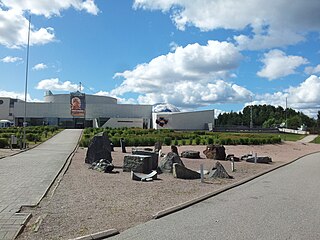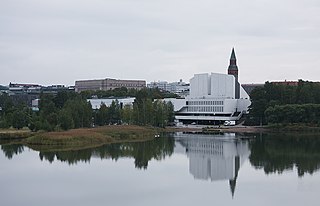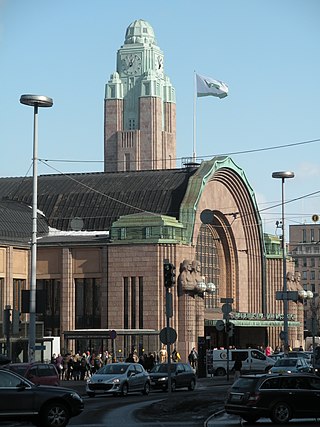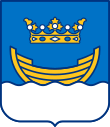
Helsinki is the capital, primate, and most populous city of Finland. Located on the shore of the Gulf of Finland, it is the seat of the region of Uusimaa in southern Finland, and has a population of 658,864. The city's urban area has a population of 1,268,296, making it by far the most populous urban area in Finland as well as the country's most important center for politics, education, finance, culture, and research; while Tampere in the Pirkanmaa region, located 179 kilometres (111 mi) to the north from Helsinki, is the second largest urban area in Finland. Helsinki is located 80 kilometres (50 mi) north of Tallinn, Estonia, 400 km (250 mi) east of Stockholm, Sweden, and 300 km (190 mi) west of Saint Petersburg, Russia. It has close historical ties with these three cities.

Vantaa is a city and municipality in Finland. It is part of the inner core of the Finnish Capital Region along with Helsinki, Espoo, and Kauniainen. With a population of 239,216, Vantaa is the fourth most populated city in Finland after Helsinki, Espoo and Tampere. Its administrative center is the Tikkurila district. Vantaa is bordered by Helsinki, the Finnish capital, to the south; Espoo to the southwest; Nurmijärvi to the northwest; Kerava and Tuusula to the north; and Sipoo to the east. The city encompasses 240.35 square kilometres (92.80 sq mi), of which 1.97 km2 (0.76 sq mi) is water.

The University of Helsinki is a public research university located in Helsinki, Finland since 1829, but founded in the city of Turku in 1640 as the Royal Academy of Åbo, at that time part of the Swedish Empire. It is the oldest and largest university in Finland with the widest range of disciplines available. In 2020, around 31,600 students were enrolled in the degree programs of the university spread across 11 faculties and 11 research institutes.

Vuosaari is a neighbourhood in the City of Helsinki, Finland. It is located by the sea in East Helsinki and with its area of 15.38 km2 (5.94 sq mi) is geographically the largest district in the city. It also has two Helsinki Metro stations, Rastila and Vuosaari

Katajanokka is a neighbourhood of Helsinki, Finland, with around 4000 inhabitants in 2005. The district is located adjacent to the immediate downtown area, though in the first major town plan for Helsinki from the mid-18th century, the area fell outside the fortifications planned to encircle the city.

Arabianranta, sometimes simply Arabia, is a residential part of Helsinki, Finland. It is bound by Vanhankaupunginlahti bay from east, and connects to neighboring boroughs of Vanhakaupunki in north, Hermanni in south and Toukola and Kumpula in west. It is part of the greater Toukola region.

Heureka is a Finnish science center in the Tikkurila district of Vantaa, Finland, north of Helsinki, designed by Heikkinen – Komonen Architects. It is located at the intersection of the Finnish Main Line and the river Keravanjoki.

The Finlandia Hall is a congress and event venue in the centre of Helsinki on the Töölönlahti Bay, owned by the City of Helsinki. The building, which was designed by architect Alvar Aalto, was completed in 1971. Every detail in the building is designed by Aalto. The designs were completed in 1962, with building taking place between 1967 and 1971. The Congress Wing was designed in 1970 and built in 1973–1975. In 2011, the building was expanded with new exhibition and meeting facilities. Finlandia Hall is known as the venue for the OSCE Summit held in August 1975, attended by 35 world leaders, including the leader of the Soviet Union, Leonid Brezhnev, and the President of the United States, Gerald Ford.

The Senate Square presents Carl Ludvig Engel's architecture as a unique allegory of political, religious, scientific and commercial powers in the centre of Helsinki, Finland.

Kulosaari is an island and an East Helsinki suburb in Helsinki, Finland. It is also the 42nd neighbourhood of the city. Construction of villas on the island started in the beginning of the 20th century, and a bridge from Sörnäinen was opened in 1919. Kulosaari was an independent municipality since 1922 until 1946, when it was merged to Helsinki.

Helsinki Central Station (HEC) is the main station for commuter rail and long-distance trains departing from Helsinki, Finland. The station is used by approximately 400,000 people per day, of whom about 200,000 are passengers. It serves as the terminus for all trains in the Helsinki commuter rail network, as well as for all Helsinki-bound long-distance trains in Finland. The Rautatientori metro station is located in the same building. All trains from Finland to Saint Petersburg and Moscow in Russia also depart from Helsinki Central Station.

Normal Lyceum of Helsinki is a school in Helsinki, Finland, consisting of the upper part of primary school and secondary school (lukio).

The Chilean recluse spider, Loxosceles laeta, is a highly venomous spider of the family Sicariidae. In Spanish, it is known as araña de rincón, or "corner spider"; in Brazilian Portuguese, as aranha-marrom or "brown spider". It is considered by many to be the most dangerous of recluse spiders, and its bites often result in serious systemic reactions, up to and including death.

Vartiovuori Observatory is a former observatory in Turku, Finland. The observatory, designed by Carl Ludvig Engel, was originally built for the Royal Academy of Turku. The neoclassical building was completed in 1819. The observatory is situated atop the Vartiovuori hill, and it is clearly visible from different sides of the city centre.

The Finnish Museum of Natural History, established in 1988, is a research institution under the University of Helsinki in Finland, based in Helsinki, Finland. It is a natural history museum responsible for the national botanical, zoological, geological and paleontological collections, which consist of samples from around the world. The collections serve scientific, public informational and educational purposes.

Rainer Mahlamäki is a Finnish architect, president of the Finnish Association of Architects (SAFA) from 2007 to 2011, Professor of Contemporary Architecture at the University of Oulu, and joint partner with Ilmari Lahdelma of the Helsinki-based architecture firm Lahdelma & Mahlamäki Architects, one of the most prolific such firms in Finland. A significant part of their work started as entries in architectural competitions, in which they have received 35 first prizes.
The following is a timeline of the history of the city of Helsinki, Finland.

Finnish art started to form its individual characteristics in the 19th century, when romantic nationalism began to rise in the autonomous Grand Duchy of Finland.
Märta Blomstedt (1899–1982) was an architect and one of the driving forces of the Finnish functionalism movement. Partnering with her husband, Pauli E. Blomstedt, her first works were noted for their functional, rather than decorative appearance and settings in park-like environments. After her husband's death, initially she formed a firm with Matti Lampén to complete projects her husband and she had begun. Later, she and Lampén formed a firm designing their own creations. She designed all aspects of her buildings including the furnishings, demonstrated in one of Blomstedt & Lampén's most noted designs of the Hotel Aulanko. During the war, Blomstedt & Lampén mostly worked on renovation and restoration projects of existing buildings, but at the war's end, they returned to their own designs. In addition to buildings, they were responsible for the city plans for Kuusjärvi and the Oravikoski Mining Community and created both public and private buildings in each city as well. When Lampén died, Blomstedt formed a partnership with Olli Penttilä and continued to work into the 1970s.

Hotel Marski is a hotel opened 1962 on Mannerheimintie 10 in Helsinki, Finland.





















